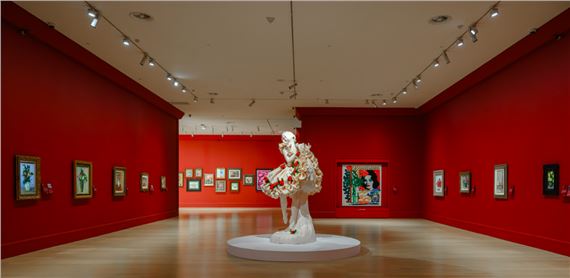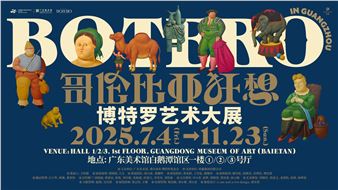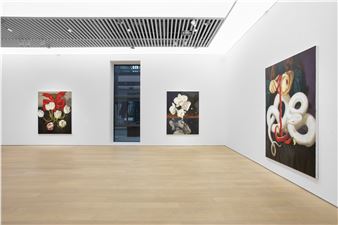Nothing Still About Still Lifes: Three Centuries of Floral Compositions
The Deji Art Museum is pleased to refresh the modern and contemporary art collection exhibition series, World of Flowers, with Nothing Still About Still Lifes: Three Centuries of Floral Compositions. The momentous return of this internationally acclaimed feast of masterworks marks the culmination of the museumÔÇÖs collecting and research of floral still lifes, and the collection will be presented in new forms inside and outside the museum space. Based on curator Dr. Joachim PissarroÔÇÖs core idea of the age-old dialogue between ÔÇ£movementÔÇØ and ÔÇ£stillness,ÔÇØ the exhibition further explores the hidden details of three centuries of art history by adding and adjusting artworks and expanding gallery narratives. Along with this new opening of the exhibition, the museum will launch a series of publications, interdisciplinary academic forums, and a public education program to enhance and concretize the contents of the exhibition, providing audiences with more diverse options to engage with art.
The ÔÇ£World of FlowersÔÇØ collection of modern and contemporary artworks from the Deji Art Museum has been established over ten years of systematic acquisition, with modern and contemporary Chinese and international floral still life works forming the main body of the collection. ÔÇ£Nothing Still About Still Lifes: Three Centuries of Floral CompositionsÔÇØ is the first exhibition curated from the ÔÇ£World of FlowersÔÇØ by Dr. Joachim Pissarro, Professor Emeritus at Hunter College of the City University of New York and former curator at The Museum of Modern Art (MoMA), New York. Exhibited artists include Claude Monet, Camille Pissarro, Paul C├®zanne, Paul Gauguin, Pablo Picasso, Piet Mondrian, Giorgio Morandi, Ren├® Magritte, Georgia OÔÇÖKeeffe and other milestone figures of Western art, members of the first and second generations of Chinese artists to study abroad such as Sanyu, Pan Yuliang, Wu Dayu, Wu Guanzhong, Zao Wou-ki and Chu Teh-Chun, modern art pioneers from other Asian countries such as L├¬ Phß╗ò, and finally major figures in contemporary art such as Andy Warhol, Yayoi Kusama, David Hockney, Jeff Koons, Yoshitomo Nara, Takashi Murakami and Damien Hirst.
While keeping the original narrative framework this time, the Deji Art Museum has made additions and adjustments to the exhibits, including representative works of great modern masters such as ├ëdouard Manet, Henri Matisse, and Tamara de Lempicka. There will also be new surprises by previously shown artists, such as Giorgio Morandi, Wu Dayu, and Zao Wou-ki. These additions further enrich the overall thesis on ÔÇ£modernityÔÇØ in the exhibition, presenting viewers with more diverse perspectives. In the contemporary art section, new works by Jeff Koons and Tom Wesselmann have been added to the exhibition. These new contemporary works cover a wide range of media, including sculpture and easel paintings, and broaden the space of imagination on botanical and ecological themes. In addition, the remarkable section on early overseas Chinese artists features classic works by Yan Wenliang, Qiu Ti and other first-generation artists who went abroad. These rare works detail episodes of exchange and development in the history of ChinaÔÇÖs modern art and supplement the exhibition with texts and documents. The exhibition will further explore the pioneering and outstanding contributions of these overseas Chinese artists and excavate and reveal the parallel artistic landscapes of China and the world in the 20th century.
This exhibition is the first dedicated to an in-depth reassessment of floral still life genre that is examined here as being anything but still. Although the floral subjects captured in these works may, at first glance, seem still or static, flowers are constantly in motion while moving at a pace that is imperceptible to the human eye. Inspired by a reflection upon the growth, reproduction, hybridization and circulation of flowers as ÔÇ£movement,ÔÇØ the exhibition is divided into four chaptersÔÇöÔÇ£Cross-Pollination,ÔÇØ ÔÇ£Avant-Gardening,ÔÇØ ÔÇ£Meta-FlowersÔÇØ and ÔÇ£Breakout BloomsÔÇØÔÇöeach opening up all-new dimensions of the dialectical relationship between ÔÇ£stillnessÔÇØ and ÔÇ£movementÔÇØ itself. Within the dimension of time and space, the global circulation of flower varieties over hundreds of years is accompanied by the cross-cultural exchange of art; in the dimension of species, changes in the relationship between human beings and flower cultivation go hand in hand with artistic creation; in the symbolic dimension, flowers in art have implied meanings and give spiritual sustenance that goes beyond surface representations of reality; finally, in the dimension of change, floral still life has always been a conduit for artists to test their skills and explore infinite possibilities for innovation.
The Deji Art Museum carries on the deeply-rooted tradition of Nanjing as a city where different civilizations exchange and interact with each other, and where different visions on nature and cosmology form and transform, placing importance on the dialogue consciousness within still life works connecting China, Asia and the rest of the world. This exhibition examines the complex relationship between floral still lifes, specific historical contexts and Zeitgeist within the past three hundred years of cultural dialogue between China and the world, revealing the important journey of flowers and floral-themed art as a means of exchange surpassing time, space and cultural boundaries between China and the West. The exhibition also explores the limitless vitality within artworks, bringing new light upon pressing issues facing humanity today such as global dynamics, the ecological crisis and the relationship between technology and civilization.

Recommended for you
The Deji Art Museum is pleased to refresh the modern and contemporary art collection exhibition series, World of Flowers, with Nothing Still About Still Lifes: Three Centuries of Floral Compositions. The momentous return of this internationally acclaimed feast of masterworks marks the culmination of the museumÔÇÖs collecting and research of floral still lifes, and the collection will be presented in new forms inside and outside the museum space. Based on curator Dr. Joachim PissarroÔÇÖs core idea of the age-old dialogue between ÔÇ£movementÔÇØ and ÔÇ£stillness,ÔÇØ the exhibition further explores the hidden details of three centuries of art history by adding and adjusting artworks and expanding gallery narratives. Along with this new opening of the exhibition, the museum will launch a series of publications, interdisciplinary academic forums, and a public education program to enhance and concretize the contents of the exhibition, providing audiences with more diverse options to engage with art.
The ÔÇ£World of FlowersÔÇØ collection of modern and contemporary artworks from the Deji Art Museum has been established over ten years of systematic acquisition, with modern and contemporary Chinese and international floral still life works forming the main body of the collection. ÔÇ£Nothing Still About Still Lifes: Three Centuries of Floral CompositionsÔÇØ is the first exhibition curated from the ÔÇ£World of FlowersÔÇØ by Dr. Joachim Pissarro, Professor Emeritus at Hunter College of the City University of New York and former curator at The Museum of Modern Art (MoMA), New York. Exhibited artists include Claude Monet, Camille Pissarro, Paul C├®zanne, Paul Gauguin, Pablo Picasso, Piet Mondrian, Giorgio Morandi, Ren├® Magritte, Georgia OÔÇÖKeeffe and other milestone figures of Western art, members of the first and second generations of Chinese artists to study abroad such as Sanyu, Pan Yuliang, Wu Dayu, Wu Guanzhong, Zao Wou-ki and Chu Teh-Chun, modern art pioneers from other Asian countries such as L├¬ Phß╗ò, and finally major figures in contemporary art such as Andy Warhol, Yayoi Kusama, David Hockney, Jeff Koons, Yoshitomo Nara, Takashi Murakami and Damien Hirst.
While keeping the original narrative framework this time, the Deji Art Museum has made additions and adjustments to the exhibits, including representative works of great modern masters such as ├ëdouard Manet, Henri Matisse, and Tamara de Lempicka. There will also be new surprises by previously shown artists, such as Giorgio Morandi, Wu Dayu, and Zao Wou-ki. These additions further enrich the overall thesis on ÔÇ£modernityÔÇØ in the exhibition, presenting viewers with more diverse perspectives. In the contemporary art section, new works by Jeff Koons and Tom Wesselmann have been added to the exhibition. These new contemporary works cover a wide range of media, including sculpture and easel paintings, and broaden the space of imagination on botanical and ecological themes. In addition, the remarkable section on early overseas Chinese artists features classic works by Yan Wenliang, Qiu Ti and other first-generation artists who went abroad. These rare works detail episodes of exchange and development in the history of ChinaÔÇÖs modern art and supplement the exhibition with texts and documents. The exhibition will further explore the pioneering and outstanding contributions of these overseas Chinese artists and excavate and reveal the parallel artistic landscapes of China and the world in the 20th century.
This exhibition is the first dedicated to an in-depth reassessment of floral still life genre that is examined here as being anything but still. Although the floral subjects captured in these works may, at first glance, seem still or static, flowers are constantly in motion while moving at a pace that is imperceptible to the human eye. Inspired by a reflection upon the growth, reproduction, hybridization and circulation of flowers as ÔÇ£movement,ÔÇØ the exhibition is divided into four chaptersÔÇöÔÇ£Cross-Pollination,ÔÇØ ÔÇ£Avant-Gardening,ÔÇØ ÔÇ£Meta-FlowersÔÇØ and ÔÇ£Breakout BloomsÔÇØÔÇöeach opening up all-new dimensions of the dialectical relationship between ÔÇ£stillnessÔÇØ and ÔÇ£movementÔÇØ itself. Within the dimension of time and space, the global circulation of flower varieties over hundreds of years is accompanied by the cross-cultural exchange of art; in the dimension of species, changes in the relationship between human beings and flower cultivation go hand in hand with artistic creation; in the symbolic dimension, flowers in art have implied meanings and give spiritual sustenance that goes beyond surface representations of reality; finally, in the dimension of change, floral still life has always been a conduit for artists to test their skills and explore infinite possibilities for innovation.
The Deji Art Museum carries on the deeply-rooted tradition of Nanjing as a city where different civilizations exchange and interact with each other, and where different visions on nature and cosmology form and transform, placing importance on the dialogue consciousness within still life works connecting China, Asia and the rest of the world. This exhibition examines the complex relationship between floral still lifes, specific historical contexts and Zeitgeist within the past three hundred years of cultural dialogue between China and the world, revealing the important journey of flowers and floral-themed art as a means of exchange surpassing time, space and cultural boundaries between China and the West. The exhibition also explores the limitless vitality within artworks, bringing new light upon pressing issues facing humanity today such as global dynamics, the ecological crisis and the relationship between technology and civilization.
Artists on show
- Andy Warhol
- Camille Pissarro
- Chu Teh-Chun
- Claude Monet
- Damien Hirst
- David Hockney
- Édouard Manet
- Georgia O'Keeffe
- Giorgio Morandi
- Henri Matisse
- Jeff Koons
- Lê Phß╗ò
- Pablo Picasso
- Pan Yu-liang
- Paul Cézanne
- Paul Gauguin
- Piet Mondrian
- Qiu Ti
- René Magritte
- Sanyu
- Takashi Murakami
- Tamara de Lempicka
- Tom Wesselmann
- Wu Dayu
- Wu Guanzhong
- Yan Wenliang
- Yayoi Kusama
- Yoshitomo Nara
- Zao Wou-Ki
Related articles
At a time when many private art institutions in China are struggling, Deji Art Museum mounts ambitious show of modern and contemporary art from its collection.

 ARTISTS
ARTISTS
















